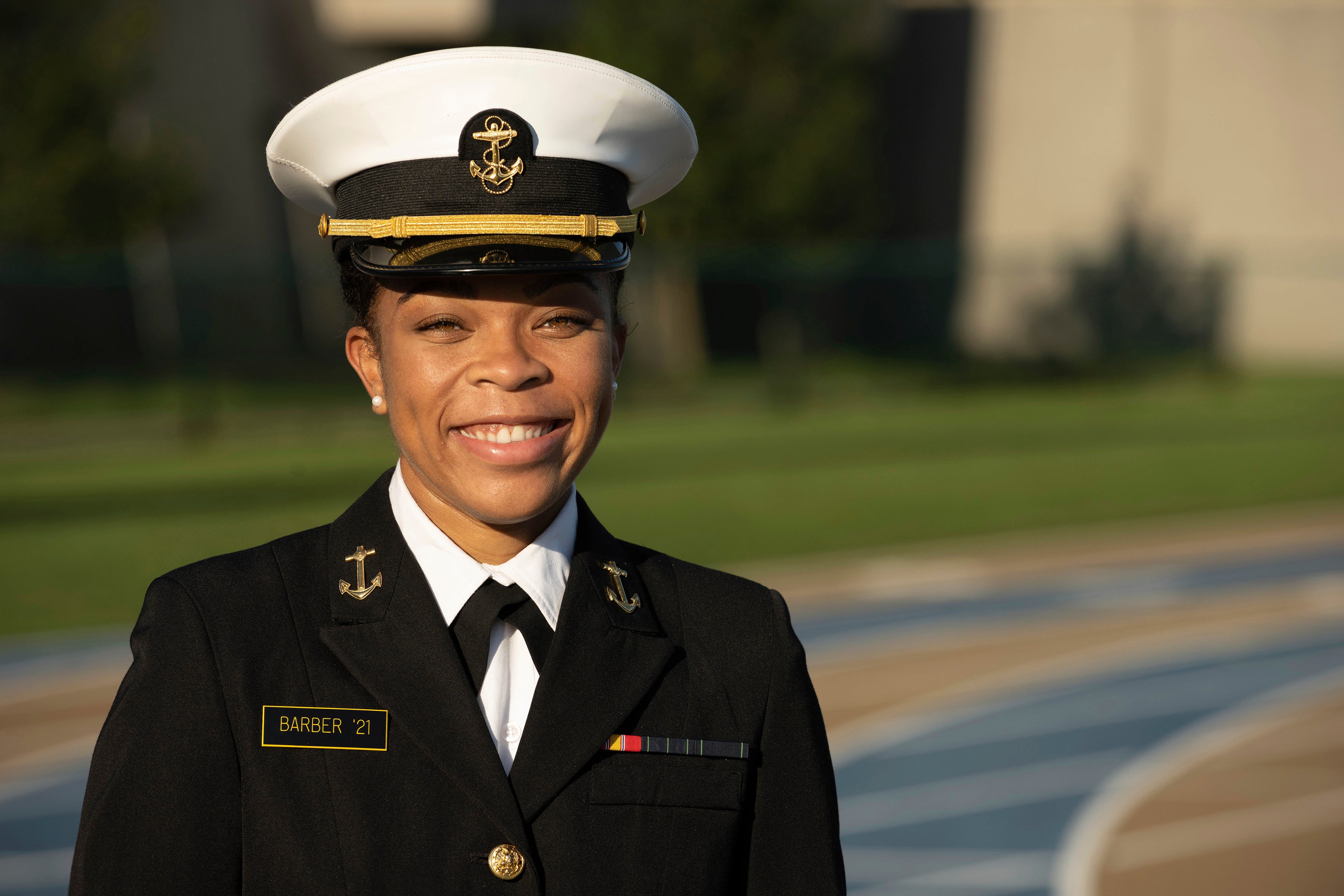Black woman to lead midshipmen at US Naval Academy for first time
Sydney Barber will become the first black woman to act as brigade commander in the US Naval Academy. She will take charge from the start of the spring term.

Students at the US Naval Academy in Annapolis, Maryland, have never been led by a black woman in the school’s 175-year history, but that will change after the holiday break when Midshipman 1st Class Sydney Barber takes charge as brigade commander for the spring term.
The 21-year-old from Lake Forest, Illinois, will wear the distinctive six stripes on her uniform and lead 4,500 midshipmen until she graduates with her degree in mechanical engineering and, as expected, commissions as a Marine Corps ground officer in May. During her tenure, Ms Barber will be responsible for much of the brigade’s daily activities as well as the professional training of other midshipmen.
Although women have been studying at the nation’s service academies since 1976, the appointment of black women to the highest cadet and midshipman leadership roles has happened only recently. In 2017, Simone Askew was selected as the cadet first captain at the US Military Academy, West Point’s equivalent position to the one Ms Barber will assume. Officials at the US Air Force Academy in Colorado Springs, Colorado, did not immediately respond to questions about whether black women have ever served in the school’s top student post, cadet wing commander.
Ms Barber graduated from Lake Forest High School in Illinois, and walked onto the academy’s track and field team as a sprinter, earning varsity letters her first three years, according to a statement from the academy. She holds the school record for the outdoor 4x400-meter relay, and is a member of several extracurricular clubs on the campus, including the academy’s gospel choir.
Ms Barber will be the 16th woman selected for brigade commander in the 44 years since Congress began allowing women to enrol in the service academies. The first was Juliane Gallina, who led the brigade in the fall of 1991, at a time when women were still prohibited from flying warplanes or serving on warships at sea. School records show Ms Gallina retired from the Navy as a commander.
The academy did not make Ms Barber available for an interview on Tuesday, but in a statement she said, “Earning the title of brigade commander speaks volumes, but the title itself is not nearly as significant as the opportunity it brings to lead a team in doing something I believe will be truly special.”
“I am humbled to play a small role in this momentous season of American history,” she added.
Wesley Brown was the first black man to graduate from the Naval Academy, in 1949. And the first black woman to enter the academy was Janie Mines, who graduated in 1980; she has also served on the staff of the secretary of the Navy and is currently a management consultant. In an interview, Mr Mines said she still mentors midshipmen at the academy and was pleasantly surprised to see a video earlier this year in which Ms Barber said it was her goal to be Ms Mines’ “wildest dream.”
“Becoming the brigade commander, I said she achieved that goal,” Ms Mines said. “She achieved my wildest dream. I’m very proud of her and academy leadership.”
Mr Brown was forced to live alone for all four years at the academy, according to Reuben E. Brigety, who in 1994 became the fourth black man to lead the brigade. The mistreatment of Mr Brown was severe until a track teammate of his — an upperclassman from Georgia named James Carter — intervened on his behalf, according to Brigety. Mr Carter later became the 39th president of the United States.
That it took so long for a black woman to be selected as brigade commander is a sign of how difficult it has been for the Navy to select minority candidates for leadership positions, said Mr Brigety, who is vice chancellor at the University of the South in Sewanee, Tennessee, and currently serves on the board of Task Force One Navy, which the service established in June to study racial issues within the Navy. In an interview, Mr Brigety said that the armed forces continue to have a problem in diversifying senior leadership, with admirals and generals often selecting people for promotion who look like them and come from similar backgrounds.
“At the end of the day you have to make the decision to give highly qualified people who are not in the majority the chance to take those leadership positions,” he said.
“The position of brigade commander is not selected by who’s done the best in their class work. In a place that is a self-described leadership laboratory, it is, ‘Who has the potential to be the leader of these leaders?’” he added. “That is a combination of skill and art and character.”
Mr Brigety described a rigorous selection process for naming a brigade commander that involved assessments by many senior commissioned officers, and said Ms Barber had proved that she was more than ready for the challenges ahead. “It is a testament not only to her, but also to the institution that it will recognize and support and promote talent in whatever form it comes,” he said.
“Representation matters, not as tokenism, but as a full commitment to our values as to what is possible,” he said. “One day we will be finished celebrating firsts, but we’re not there yet.”
The New York Times
Join our commenting forum
Join thought-provoking conversations, follow other Independent readers and see their replies
Comments


Bookmark popover
Removed from bookmarks